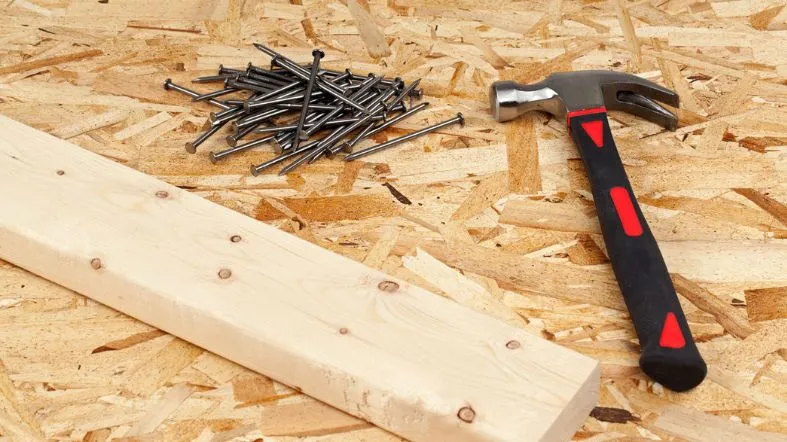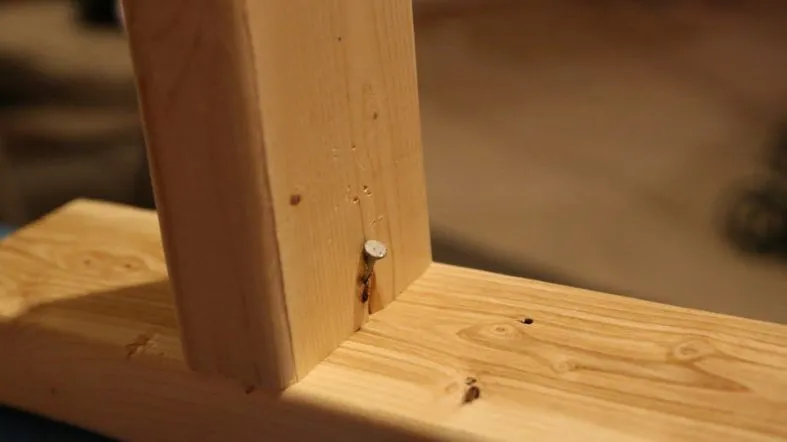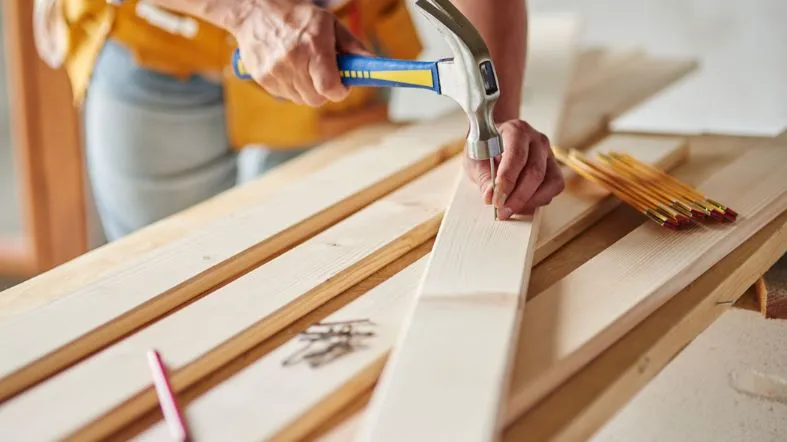Looking to start a woodworking project with 2x4s but confused about what size nails for nailing 2×4 together? You’re not alone!
Choosing the right nail size is crucial for the strength and durability of your DIY masterpiece, be it a treehouse, a garden bench, or even a simple bookshelf.
In this handy guide, we’ll delve into the specifics of nail sizes, types, and their uses for different 2×4 projects.

What Size Nails Should You Use for Nailing 2×4 Together?
For nailing 2x4s together, 16d (3 1/2-inch) common nails are typically recommended for framing. If you’re using a nail gun, 3 1/4-inch framing nails are also suitable. These nails provide the right length and strength to securely join 2×4 wood boards.
Nail Types, Sizes, and Their Specific Uses
| Nail Type | Size | Specific Use |
|---|---|---|
| Common Nails | 3-1/2″ (16d) | General framing, especially for softwood |
| Box Nails | 3″ (10d) | Lighter framing tasks, less likely to split wood |
| Ring Shank Nails | 3-1/2″ (16d) | Greater holding power, ideal for hardwood |
| Spiral Nails | 3-1/2″ (16d) | Good holding power, used in both softwood and hardwood |
Different Types of Nails You Can Use for 2x4s
Common Nails
Common nails are the go-to choice for general framing tasks. They have a smooth body and a flat head, which makes them easy to hammer into 2x4s.
For example, if you’re building a simple wooden shelf, common nails would be a great choice. They provide a strong hold and are easy to work with.
Box Nails
Box nails are thinner than common nails, which makes them less likely to split the wood. This is especially useful when you’re working with delicate or thin pieces of wood.
For instance, if you’re crafting a small birdhouse out of 2x4s, box nails would be ideal as they reduce the risk of splitting the wood.
Ring Shank Nails
Ring shank nails are unique because they have rings on their shanks that lock with the wood fibers. This gives them excellent holding strength.
They’re often used with softwoods where a strong grip is needed. So, if you’re building a treehouse with 2×4 pine boards, ring shank nails would provide a secure hold.
Spiral Nails
Spiral nails have a special feature: they rotate as you drive them in, much like threads on a screw. This rotation makes it easier to drive into the wood and helps keep the nail in place.
If you’re working on a project where the 2x4s will be under a lot of stress, like a wooden bench, spiral nails would be an excellent choice.
How to Choose the Right Nail Size for Nailing 2×4 Together

Know the Thickness of Your 2×4 Boards
First, measure the thickness of your 2×4 boards. Even though we call them “2x4s,” they usually measure about 1.5 inches by 3.5 inches.
Knowing the exact thickness helps you pick the right nail size. Let’s say your 2×4 boards are actually 1.5 inches thick. Write this number down; you’ll need it soon.
Nail Length Matters: The 3 Times Rule
A good rule to follow is the “3 Times Rule”. This rule says that your nail should be three times longer than the thickness of the thinner board you’re nailing.
So, if your 2×4 is 1.5 inches thick, you multiply 1.5 by 3. The answer is 4.5 inches. Choose nails close to 4.5 inches for strong and secure connections.
Nail Diameter: Opt for 16D or 10D Nails
The nail’s diameter is another key factor. The bigger the number, the thicker the nail.
For 2x4s, a 16d nail (which is 3.5 inches long) or a 10d nail (which is 3 inches long) usually works well. These nails are sturdy and will hold your 2×4 boards together tightly.
Nail Type: Use Common Nails for General Use
Choose the right type of nail for your project. Common nails are good for most 2×4 projects because they have a thicker shaft and a large, flat head.
This makes them strong and easy to hammer in. For example, if you’re building a treehouse, common nails will give the wood more stability.
Consider the Material: Coated Nails for Extra Grip
If you want extra grip, go for coated nails. These nails have a layer of resin that melts slightly when you hammer them in.
This helps the nail grip the wood better. Imagine you’re making an outdoor table; coated nails will make it more durable against forces that might try to pull the boards apart.
Check for Nail Consistency: Shake the Box
Before buying, give the nail box a good shake. Listen closely. If you hear too much rattling, that means the nails may have inconsistent sizes. You want a box where all the nails are pretty much the same.
Inconsistent nails can make your project wobbly, like a chair that rocks because one leg is shorter.
Test the Nails: Do a Trial Run
Before you start your big project, test a few nails on some scrap 2x4s. Hammer them in and try pulling the boards apart.
Do they hold tightly? Great! You’ve probably chosen the right nail size and type. If not, go back to the store and consult the tips above again.
Count the Nails: Calculate Your Needs
Finally, count how many nails you’ll need for your project. It’s better to buy a bit more than to run out in the middle of your work.
For instance, if you’re building a small bookshelf, calculate the number of connections and then add 10% more nails for any mistakes or extras you might need.
Factors That Affect Nail Size Selection for 2x4s

Material of the 2x4s
The type of wood you’re using will affect your choice of nail.
For example, if you’re using a softwood like pine, you might need a thinner nail to avoid splitting the wood. But if you’re using a hardwood like oak, you can use a thicker nail.
Load-Bearing Requirements
Consider what kind of load your structure will need to bear. If you’re building something that needs to support a lot of weight, like a bookshelf, you’ll need larger, stronger nails.
But if you’re building something lighter, like a picture frame, smaller nails should do the trick.
Nail Penetration and Placement
The way you plan to drive the nail can affect your choice of nail size. If you’re driving the nail straight in, you can use a longer nail.
But if you’re driving the nail at an angle (a technique called “toe-nailing”), you might need a shorter nail.
Environmental Conditions
The climate where your structure will be located can affect your choice of nail. For example, if you live in a humid area, you might want to choose galvanized nails that resist rust.
Tools Available
The tools you have available can also affect your choice of nail. If you have a powerful hammer or a nail gun, you can use longer and thicker nails. But if you only have a small hammer, it might be easier to work with smaller nails.
Building Codes and Regulations
Always check local building codes and regulations when choosing materials for a project. Some areas might have specific requirements for the type or size of nails used in construction.
Common Mistakes to Avoid When Nailing 2x4s Together
Using the Wrong Nail Type
Using the wrong type or size of nail can weaken your structure.
For example, using a small nail for a heavy-duty project like a deck can cause the structure to be unstable. Always make sure to use the right nail for the job!
Ignoring Safety Guidelines
Safety should always be your top priority when working with tools and materials. Always wear safety glasses and gloves, and make sure to handle nails and hammers carefully. Remember, it’s better to be safe than sorry!
Poor Nail Placement
Nail placement is crucial for the stability of your structure. Poor placement can weaken your structure and even cause it to collapse.
For example, if you’re building a shelf, you need to make sure the nails are evenly spaced and driven straight in.
Not Considering Weather Conditions
If your structure will be outdoors, consider how weather conditions might affect your choice of materials.
For instance, if you live in a rainy area, you might want to use galvanized nails that resist rust. Don’t let the weather ruin your hard work!
FAQs
Can I use 10d nails for 2×4 framing?
Is it necessary to measure the actual thickness of 2×4 boards?
Are coated nails better for outdoor projects?
Does nail placement affect the strength of the structure?
Are galvanized nails recommended for humid conditions?
Conclusion
Choosing the right nail size for nailing 2x4s together is crucial for a sturdy and safe structure. Always consider the influencing factors and avoid common mistakes. Happy building!
